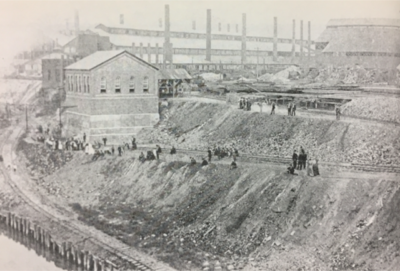Since Covid-19 disrupted business and society, a major question has loomed: will the economic crisis prompt a rethink of society that leads to greater equity and justice, or will it retrench existing inequities? From the 2008 financial crisis to the Great Depression and further back still, the history of economic crisis in America offers examples of both possibilities. Professor Barry M. Mitnick of the University of Pittsburgh knows this well. Professor Mitnik is the winner of an Aspen Ideas Worth Teaching Award for his course, “Market Manipulations: Crises, Bubbles, Robber Barons, and Corporate Saints.” Aspen BSP has a long-standing belief in the value of history and other humanities in providing needed context to business decisions. (Find out more about our work in this space here.) Mitnick exposes business students to both traditional and unconventional historical accounts to distill lessons that stand the test of time. While the course focuses primarily on financial crises triggered by market manipulations rather than sudden shocks like a pandemic, the historic perspective holds numerous insights for the present.
Professor Mitnik is the winner of an Aspen Ideas Worth Teaching Award for his course, “Market Manipulations: Crises, Bubbles, Robber Barons, and Corporate Saints.” Aspen BSP has a long-standing belief in the value of history and other humanities in providing needed context to business decisions. (Find out more about our work in this space here.) Mitnick exposes business students to both traditional and unconventional historical accounts to distill lessons that stand the test of time. While the course focuses primarily on financial crises triggered by market manipulations rather than sudden shocks like a pandemic, the historic perspective holds numerous insights for the present.
From speculation to rule-bending to outright scams, exploiting the market for private gain has a long and storied history with lessons for the present day. To what extent should we think of market manipulations as consciously driven by individuals vs. fostered by systems? In what ways can they be managed?
Although as a course in business history, Market Manipulations contains a great deal of essential historical description, this is a course that treats history as social science.
By that I mean that its goal is not only to understand why and how a particular historical event occurred as it did, but how we can conceptually join events to generalize to patterns that inform us not only about the past, but about the present and the future. This is the classic reason to study history — to avoid the errors of the past. For example, after reviewing all the major financial panics in U.S. history, we develop generalizations about their commonalities — which should inform us looking forward to the next such crisis.
We study and generalize, for example, the detailed strategies used by Andrew Carnegie and John D. Rockefeller to build their businesses into monopolies or near-monopolies. Although many of their strategies are now outlawed, they were perfectly legal at the time. In the absence of securities laws, the strategies used by Thomas Durant and his colleagues in the Credit Mobilier scandal to pocket huge sums during the building of the Transcontinental Railroad were largely legal. The study of such market manipulations informs us about how prospective monopolists and/or unregulated financial markets behave.
The corruption of the Gilded Age was systemic and pervasive. When we see it only as something done by individuals of its time, however, we lose the opportunity to understand its generalizable nature — and we lose the ability to inform the design of modern systems to manage such behaviors. We still struggle to manage financial panics and modern monopolies, but we are much further along when we treat history as a generalizable social science.
To engage students with the historical reality of turn-of-the-century financial panics, your course makes use of both reading a science fiction novel about time travel, and visits to historic iron sites. Why was it important for business students to experience the past in this way, in addition to reading traditional financial history?
The central theme of this course is that the past is generalizable to the future, even as specific events and contexts may be special to their time. I want students to feel they are, like the hero of Time and Again, traveling in time — that it is as real as their everyday experience, and can be generalized to their lives, including their business lives, today.
Jack Finney’s science fiction novel Time and Again immerses its characters in the accurately-depicted New York City of 1882. The novel includes detailed descriptions of what everyday business was like at the time — an era before any significant regulation existed in the U.S. (the first major federal business regulation came with the Interstate Commerce Act of 1887).
Unlike Finney’s characters we cannot time travel, but we are fortunate to be able to offer this course in Pittsburgh, so central to relevant Gilded Age events. This is the city of Carnegie and Westinghouse, two industrialists who took polar approaches to managing their employees, and from whose managerial strategies we generalize.
When we visit Carrie Furnaces, the docent takes us through the iron works and describes not only how the iron that was shipped across the river to the Homestead steel works was made, but what the lives of the iron and steelworkers were like (including 12-hour work days every day of the year except July 4th and the lack of bathrooms in the mill).

We then go to the site of the Homestead works, now a large shopping center. We visit one of the few remaining structures and stand above the Monongahela River, exactly where Pinkerton strikebreakers exchanged fire with steelworkers. Although there is landfill on the bank above the river, the bullets from that fight are very likely still buried below us. At the Bost Building, where the union had its headquarters, we go to the upstairs room where dozens of union leaders gathered in the heat of July 1892, dramatically threw away their union badges and burned the union’s papers. Being able to visit these sites makes the course content not only memorable, but its generalizations credible.
There’s been a lot of debate about whether the current coronavirus-triggered economic crisis will lead to reforms that make society more equitable, or if it will merely intensify existing social inequities. Looking at the many examples surveyed in your course, from the 19th century to the Great Depression to the 2008 financial crisis, what factors make a crisis lead to positive change (or not)?
Regulation tends to arrive after a real or perceived crisis, but it helps a great deal if there are effective agents that advocate for it. For example, the Pure Food and Drug Act of 1906 was helped along by an internal advocate (in the Department of Agriculture), Dr. Harvey W. Wiley, an external muckraker, Samuel Hopkins Adams, and a company, H.J. Heinz, that perceived the regulation as disadvantaging competitors selling adulterated product.
The Panic of 1907 led to the creation of the Federal Reserve System. The initial designs for the Fed were done by the banking industry — which saw the new regulation as in their self-interest.
In 1894, streams of unemployed workers in “Coxey’s Army” marched from all over the U.S. toward Washington to demand a government public works program and other changes to relieve the severe impacts of the depression of the Panic of 1893. Rather than delivering a dramatic speech on the steps of the U.S. Capitol, Jacob Coxey was arrested for trespassing on the grass. It wasn’t until the major economic disruption of the Great Depression, a landslide election in 1932 and a leader — FDR — committed to using government to effect positive change that Coxey’s proposals saw light in the New Deal.
Nothing much happens until a crisis makes people believe that change is essential and major actors find the change in their self-interest to lead it.
As alumni from your course go into leadership positions across industries and sectors, what is the one lesson that you hope will stick with them throughout their careers?
That the actions of individuals can make a difference in corrupt systems, even if they require, as the song goes, a little help from their friends.
George Westinghouse stood very much apart from the pattern of Gilded Age industrialists. Carnegie and Rockefeller managed cost; Carnegie’s workers lived in slums with raw sewage in the streets, and paid rent to the company to do so. Westinghouse managed invention and expansion, and built houses with vegetable gardens for his workers. He is credited with inventing the weekend for American workers — giving his employees a half day off on Saturday as well as all of Sunday. There were many deaths in Carnegie’s mills; there were not only few injuries, but infirmaries — and bathrooms — in Westinghouse’s factories.
An engineer, Westinghouse saw his role as creating inventions that would both make life better and create value for his companies. He is famously quoted as saying, “If someday they say of me that in my work I have contributed something to the welfare and happiness of my fellow men, I shall be satisfied.” This is a motto that would serve American business well today.
![]()
Interested in more innovative insights for business education? Browse our complete collection of interviews with outstanding educators, and subscribe to our weekly Ideas Worth Teaching digest!

